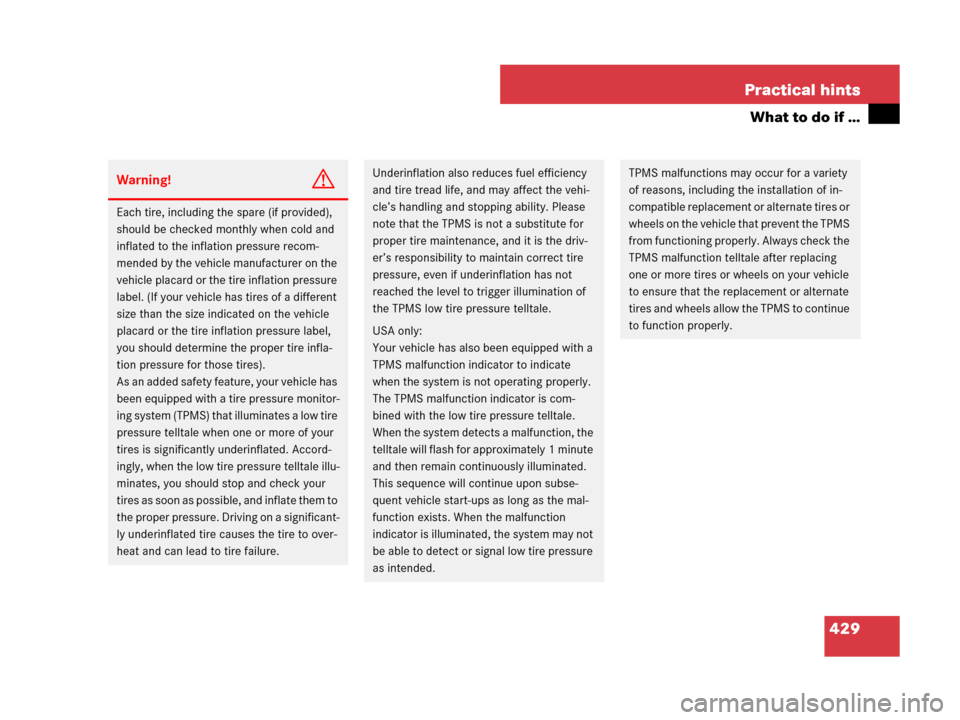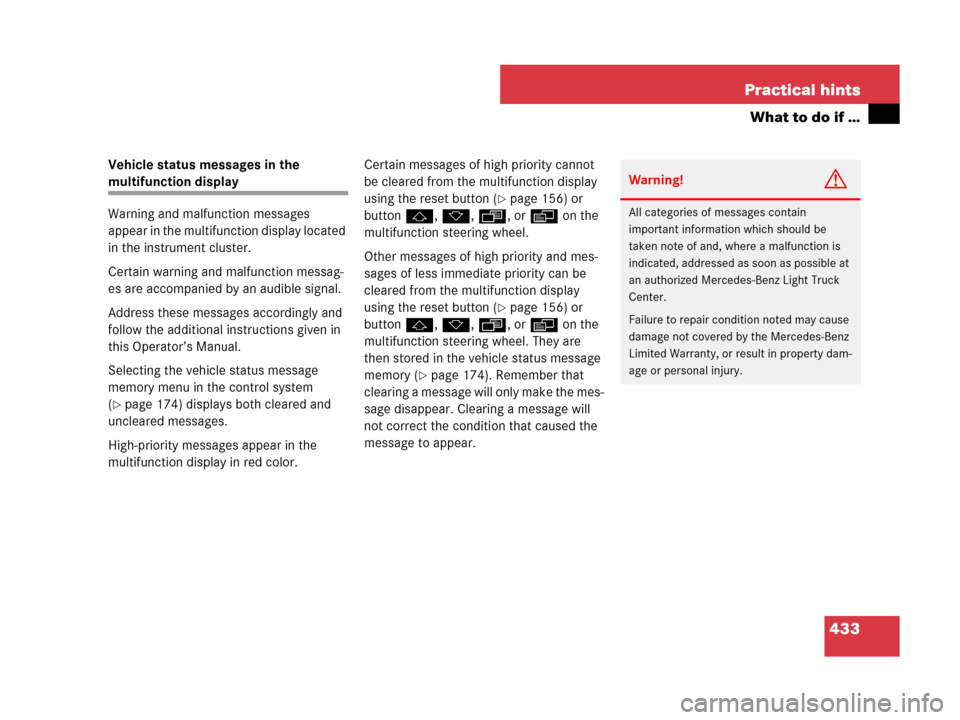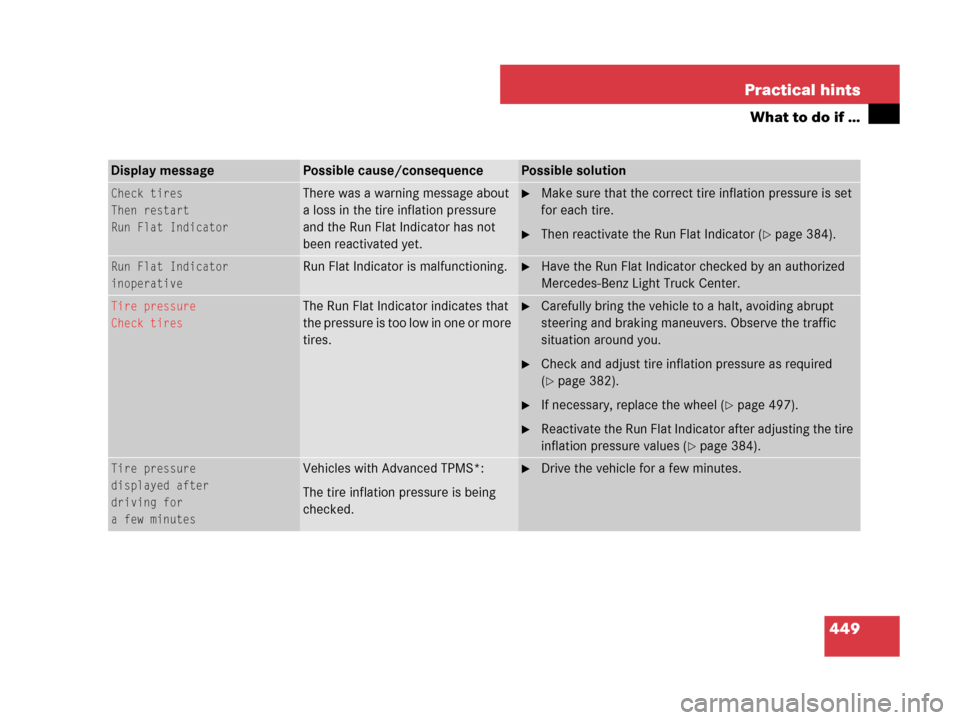Page 419 of 570
418 Operation
Vehicle care
Leather upholstery
Please note that leather upholstery is a
natural product and is therefore subject
to a natural aging process. Leather up-
holstery may also react to certain ambient
influences such as high humidity or high
temperature by showing wrinkles for
example.
�Wipe leather upholstery with a damp
cloth and dry thoroughly or clean with
Mercedes-Benz approved Leather
Care.
Exercise particular care when cleaning
perforated leather as its underside should
not become wet.Wood trims
�Dampen cloth using water and use
damp cloth to clean wood trims in your
vehicle.
!Wipe with light pressure to avoid damage to
the upholstery.
!Do not use solvents like tar remover or
wheel cleaner nor polishes or waxes as these
may be abrasive.
Page 421 of 570

420 Practical hints
What to do if …
Lamps in instrument clusterGeneral information:
If any of the following lamps in the instru-
ment cluster fails to come on during thebulb self-check when switching on the
ignition, have the respective bulb checked
and replaced if necessary.
ProblemPossible cause/consequenceSuggested solution
-The yellow ABS indicator lamp
comes on while the engine is
running.ABS has detected a malfunction and has
switched off. The BAS, ESP®, EBP, and 4-ETS
are also switched off (see messages in multi-
function display).
The brake system is still functioning normally
but without the ABS available.
If the ABS control unit is malfunctioning,
other systems such as the navigation
system* or the automatic transmission may
also be malfunctioning.
�Continue driving with added caution.
Wheels may lock during hard braking,
reducing steering capability.
�Read and observe messages in the
multifunction display (
�page 433).
�Have the system checked at an
authorized Mercedes-Benz Light
Truck Center as soon as possible.
Failure to follow these instructions
increases the risk of an accident.
The charging voltage has fallen below
10 volts. The ABS has switched off.
The battery might not be charged sufficiently.When the voltage is above this value
again, the ABS is operational again and
the ABS indicator lamp should go out.
If the ABS indicator lamp does not go out:
�Have the generator (alternator) and
the battery checked.
Page 430 of 570

429 Practical hints
What to do if …
Warning!G
Each tire, including the spare (if provided),
should be checked monthly when cold and
inflated to the inflation pressure recom-
mended by the vehicle manufacturer on the
vehicle placard or the tire inflation pressure
label. (If your vehicle has tires of a different
size than the size indicated on the vehicle
placard or the tire inflation pressure label,
you should determine the proper tire infla-
tion pressure for those tires).
As an added safety feature, your vehicle has
been equipped with a tire pressure monitor-
ing system (TPMS) that illuminates a low tire
pressure telltale when one or more of your
tires is significantly underinflated. Accord-
ingly, when the low tire pressure telltale illu-
minates, you should stop and check your
tires as soon as possible, and inflate them to
the proper pressure. Driving on a significant-
ly underinflated tire causes the tire to over-
heat and can lead to tire failure.
Underinflation also reduces fuel efficiency
and tire tread life, and may affect the vehi-
cle’s handling and stopping ability. Please
note that the TPMS is not a substitute for
proper tire maintenance, and it is the driv-
er’s responsibility to maintain correct tire
pressure, even if underinflation has not
reached the level to trigger illumination of
the TPMS low tire pressure telltale.
USA only:
Your vehicle has also been equipped with a
TPMS malfunction indicator to indicate
when the system is not operating properly.
The TPMS malfunction indicator is com-
bined with the low tire pressure telltale.
When the system detects a malfunction, the
telltale will flash for approximately 1 minute
and then remain continuously illuminated.
This sequence will continue upon subse-
quent vehicle start-ups as long as the mal-
function exists. When the malfunction
indicator is illuminated, the system may not
be able to detect or signal low tire pressure
as intended.TPMS malfunctions may occur for a variety
of reasons, including the installation of in-
compatible replacement or alternate tires or
wheels on the vehicle that prevent the TPMS
from functioning properly. Always check the
TPMS malfunction telltale after replacing
one or more tires or wheels on your vehicle
to ensure that the replacement or alternate
tires and wheels allow the TPMS to continue
to function properly.
Page 434 of 570

433 Practical hints
What to do if …
Vehicle status messages in the
multifunction display
Warning and malfunction messages
appear in the multifunction display located
in the instrument cluster.
Certain warning and malfunction messag-
es are accompanied by an audible signal.
Address these messages accordingly and
follow the additional instructions given in
this Operator’s Manual.
Selecting the vehicle status message
memory menu in the control system
(
�page 174) displays both cleared and
uncleared messages.
High-priority messages appear in the
multifunction display in red color.Certain messages of high priority cannot
be cleared from the multifunction display
using the reset button (
�page 156) or
buttonj,k,ÿ, orè on the
multifunction steering wheel.
Other messages of high priority and mes-
sages of less immediate priority can be
cleared from the multifunction display
using the reset button (
�page 156) or
buttonj,k,ÿ, orè on the
multifunction steering wheel. They are
then stored in the vehicle status message
memory (
�page 174). Remember that
clearing a message will only make the mes-
sage disappear. Clearing a message will
not correct the condition that caused the
message to appear.
Warning!G
All categories of messages contain
important information which should be
taken note of and, where a malfunction is
indicated, addressed as soon as possible at
an authorized Mercedes-Benz Light Truck
Center.
Failure to repair condition noted may cause
damage not covered by the Mercedes-Benz
Limited Warranty, or result in property dam-
age or personal injury.
Page 436 of 570

435 Practical hints
What to do if …
Text messages
Display messagePossible cause/consequencePossible solution
ABSinoperative
See Operator's ManualThe ABS has detected a malfunction
and has switched off.
The ESP
® and the BAS are also
deactivated.
The brake system is still functioning
normally but without the ABS avail-
able.
�Continue driving with added caution.
Wheels may lock during hard braking,
reducing steering capability.
�Have the system checked at an authorized
Mercedes-Benz Light Truck Center as soon
as possible.
Failure to follow these instructions increases
the risk of an accident.
unavailable
See Operator’s ManualThe ABS was deactivated because of
insufficient power supply. The charg-
ing voltage has fallen below 10 volts.
The brake system is still functioning
normally but without the ABS
available.When the voltage is above this value again, the
ABS is operational again and the message in
the multifunction display should disappear.
If the message in the multifunction display
does not disappear:
�Have the generator (alternator) and the
battery checked.
Page 437 of 570

436 Practical hints
What to do if …
Display messagePossible cause/consequencePossible solution
ABSunavailable
See Operator’s ManualIf the yellow ESP® warning
lampv flashes while driving and
this message appears, the electron-
ic traction system has switched off
to prevent overheating of the drive
wheel brakes.As soon as the brakes have cooled off, the
electronic traction system switches on again.
The message in the multifunction display disap-
pears and the ESP
® warning lampv goes
out.
The self-diagnosis has not yet been
completed yet.The display will clear after driving a short
distance at a vehicle speed of above
12 mph (20 km/h).
Cruise
control and
SPEEDTRONIC
inoperativeThe cruise control is malfunctioning.�Have cruise control checked by an
authorized Mercedes-Benz Light Truck
Center.
Cruise
control––– mphYou have attempted to set a
speed while driving below
20 mph (30 km/h).�Accelerate to a speed exceeding
20 mph (30 km/h) and set the speed
(
�page 266).
The ESP® is switched off.�Switch on the ESP® (�page 105).
The automatic transmission is set to
position P, R, or N.�Set the automatic transmission to
positionD (
�page 197).
The vehicle is secured with the
parking brake.�Release the parking brake (�page 57).
Page 443 of 570

442 Practical hints
What to do if …
Display messagePossible cause/consequencePossible solution
ESPunavailable
See Operator’s ManualThe ESP® was deactivated because
of insufficient power supply. The
charging voltage has fallen below
10 volts.
The brake system is still functioning
normally but without the ESP
®
available.
When the voltage is above this value again, the
ESP® is operational again and the message in
the multifunction display should disappear.
If the message in the multifunction display
does disappear:
�Have the generator (alternator) and the
battery checked.
If the yellow ESP® warning
lampv flashes while driving and
this message appears, the electron-
ic traction system has switched off
to prevent overheating of the drive
wheel brakes.As soon as the brakes have cooled off, the
electronic traction system switches on again.
The message in the multifunction display disap-
pears and the ESP
® warning lampv goes
out.
The self-diagnosis has not been
completed yet.The display will clear after driving a short
distance at a vehicle speed of above
12 mph (20 km/h).
Page 450 of 570

449 Practical hints
What to do if …
Display messagePossible cause/consequencePossible solution
Check tires
Then restart
Run Flat IndicatorThere was a warning message about
a loss in the tire inflation pressure
and the Run Flat Indicator has not
been reactivated yet.�Make sure that the correct tire inflation pressure is set
for each tire.
�Then reactivate the Run Flat Indicator (�page 384).
Run Flat Indicator
inoperativeRun Flat Indicator is malfunctioning.�Have the Run Flat Indicator checked by an authorized
Mercedes-Benz Light Truck Center.
Tire pressure
Check tiresThe Run Flat Indicator indicates that
the pressure is too low in one or more
tires.�Carefully bring the vehicle to a halt, avoiding abrupt
steering and braking maneuvers. Observe the traffic
situation around you.
�Check and adjust tire inflation pressure as required
(
�page 382).
�If necessary, replace the wheel (�page 497).
�Reactivate the Run Flat Indicator after adjusting the tire
inflation pressure values (
�page 384).
Tire pressure
displayed after
driving for
a few minutesVehicles with Advanced TPMS*:
The tire inflation pressure is being
checked.�Drive the vehicle for a few minutes.